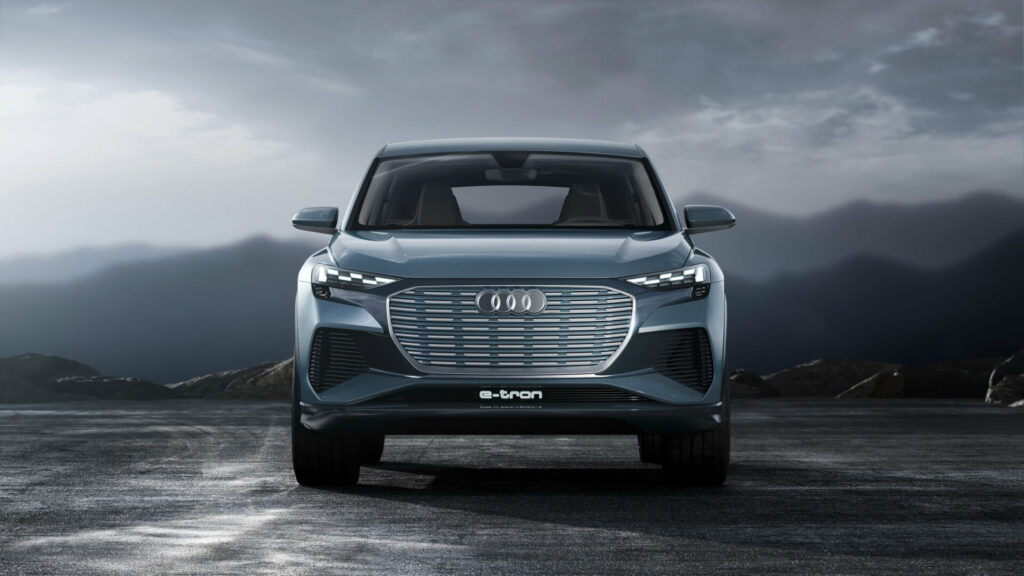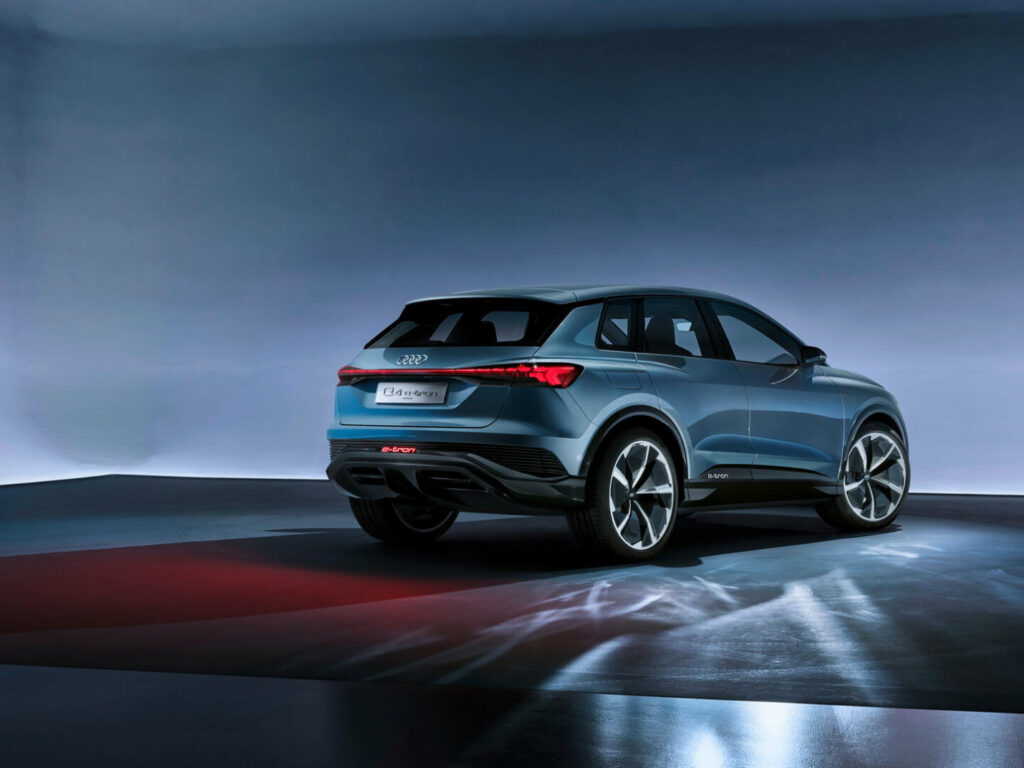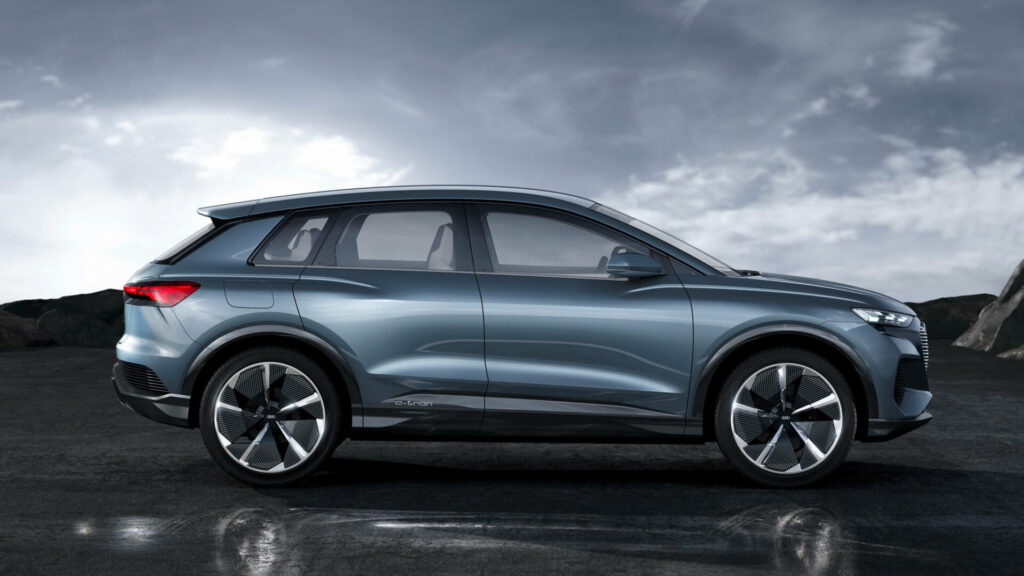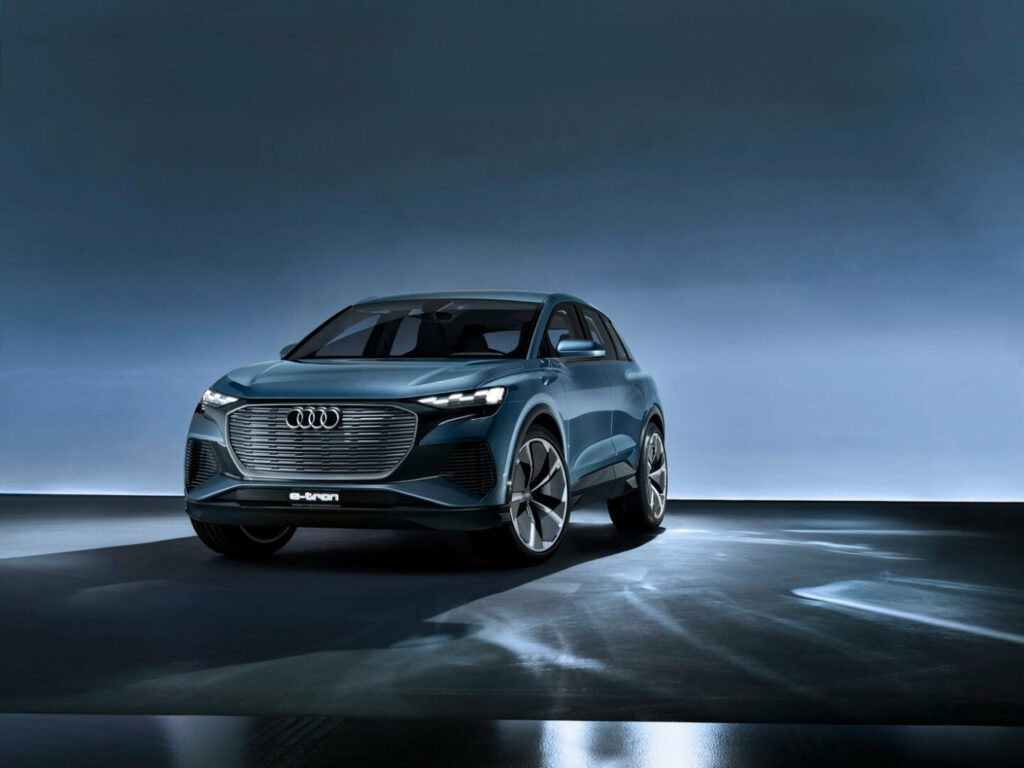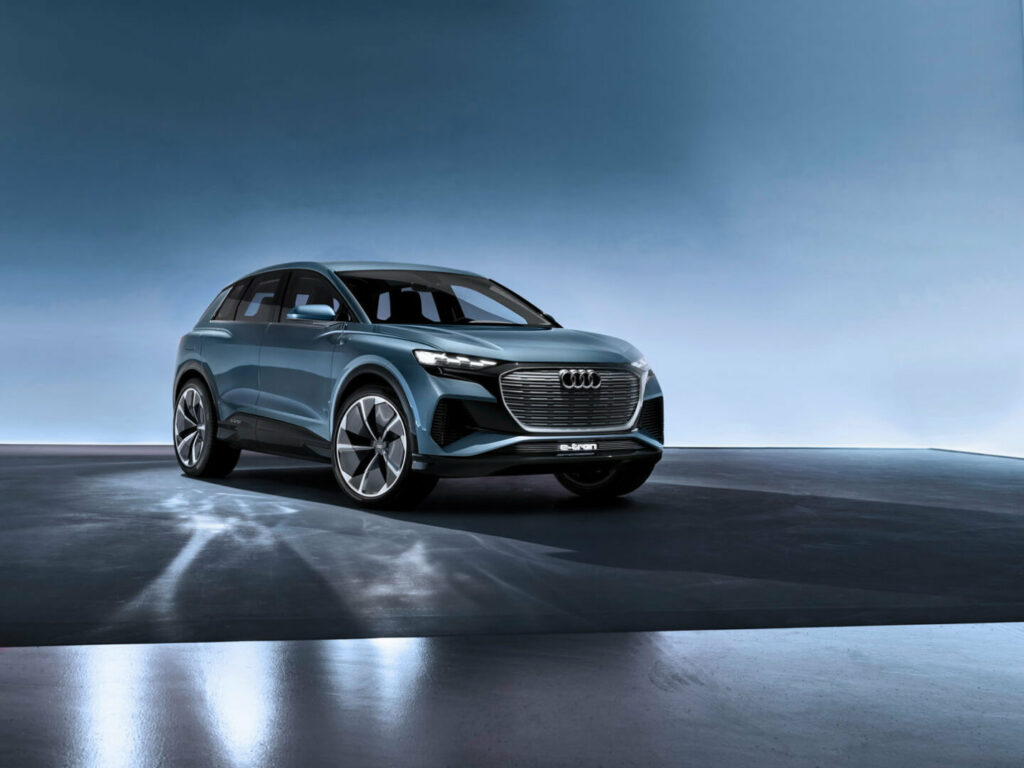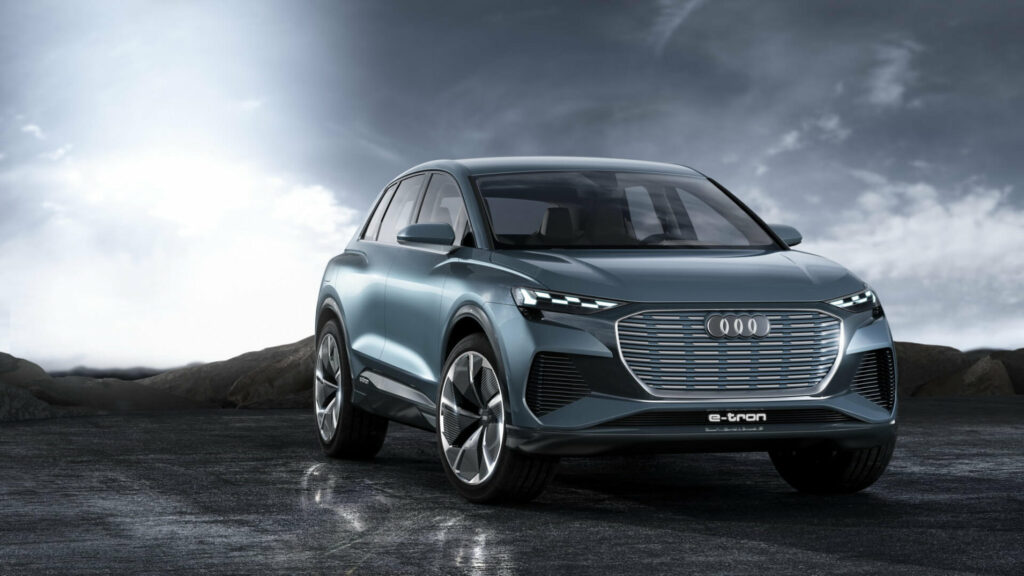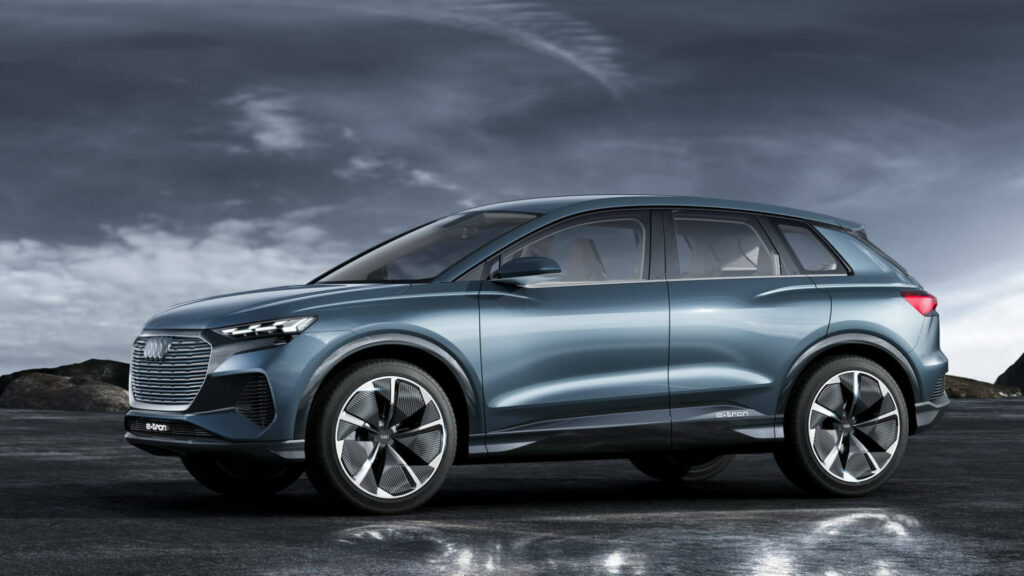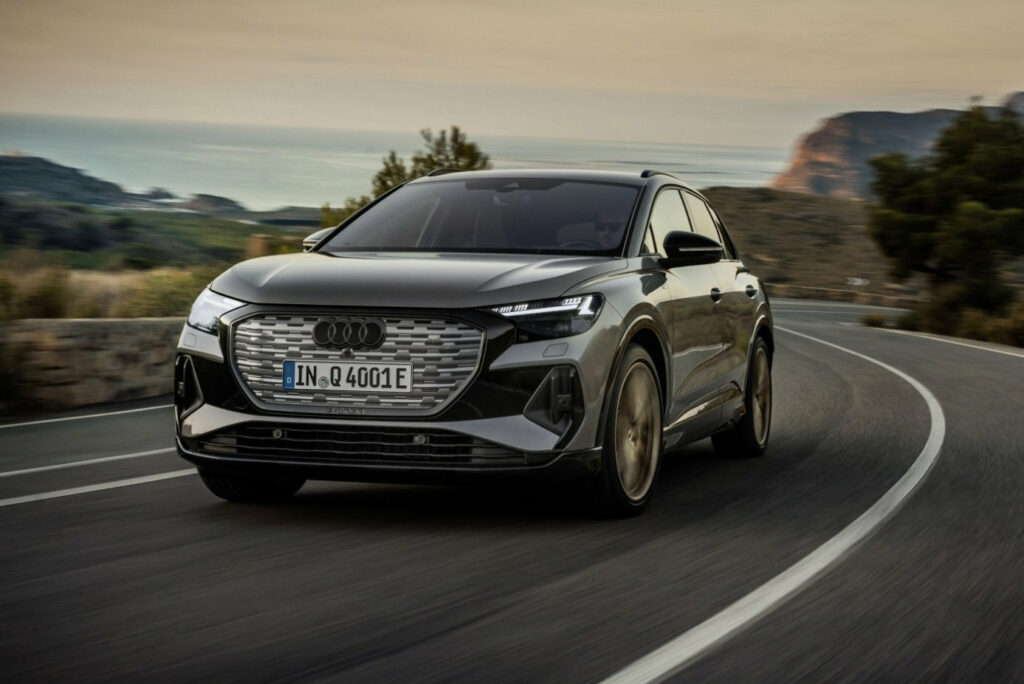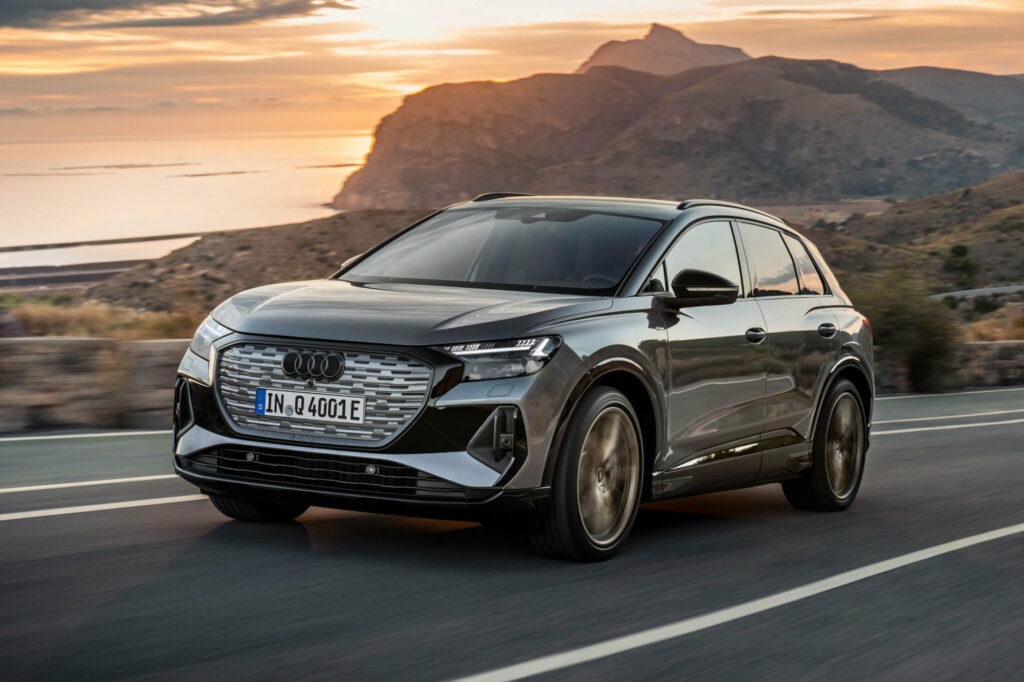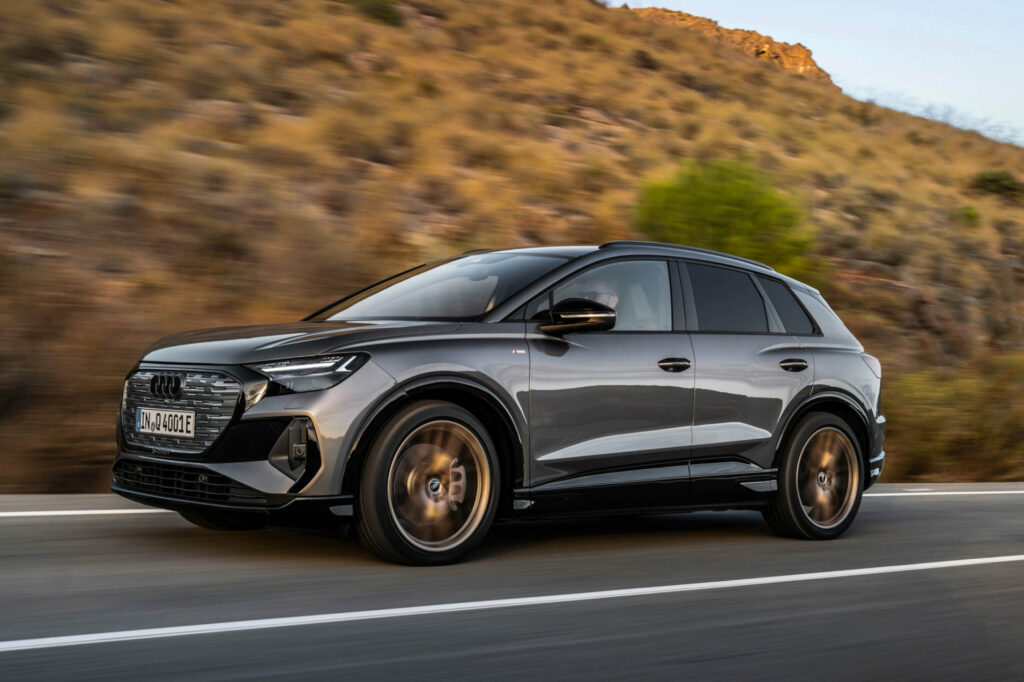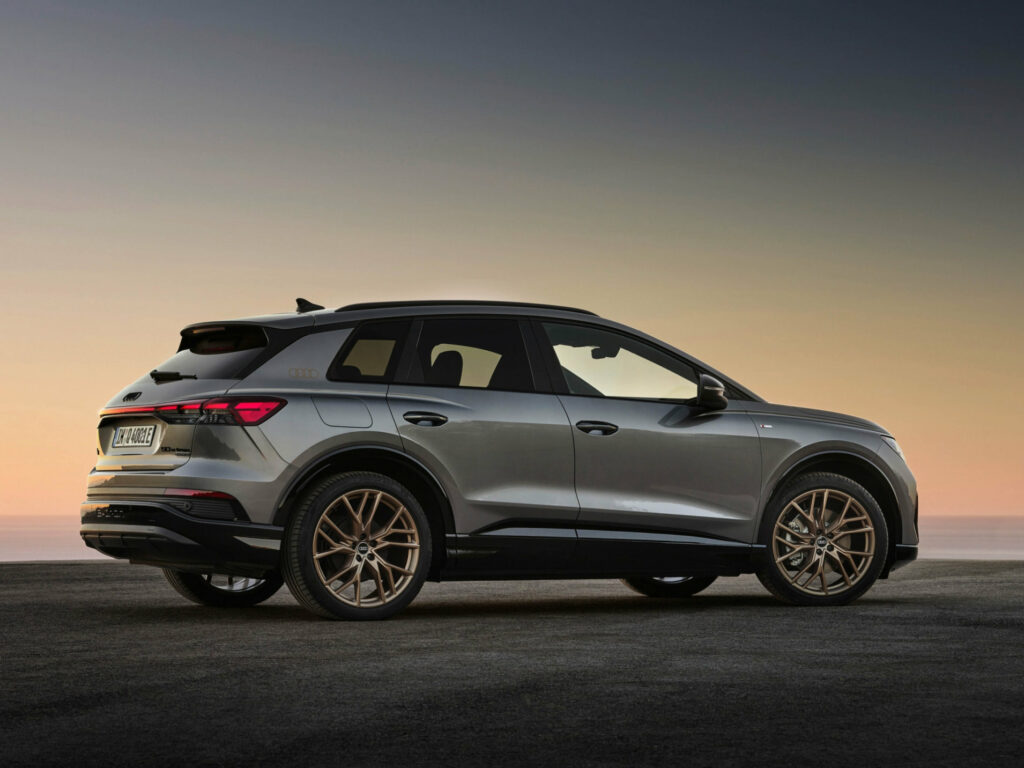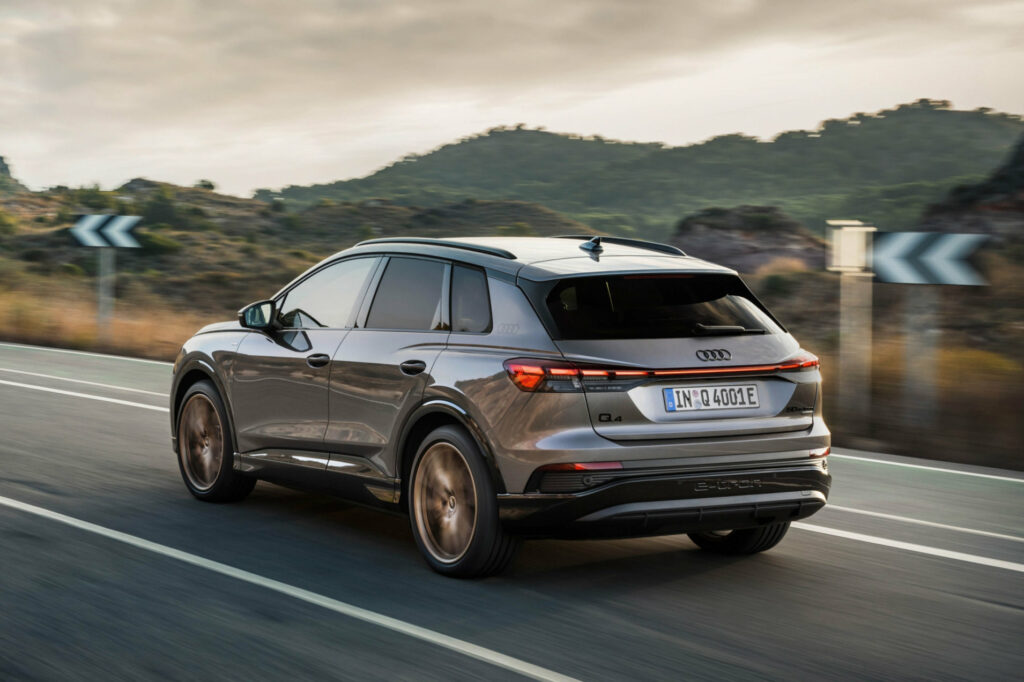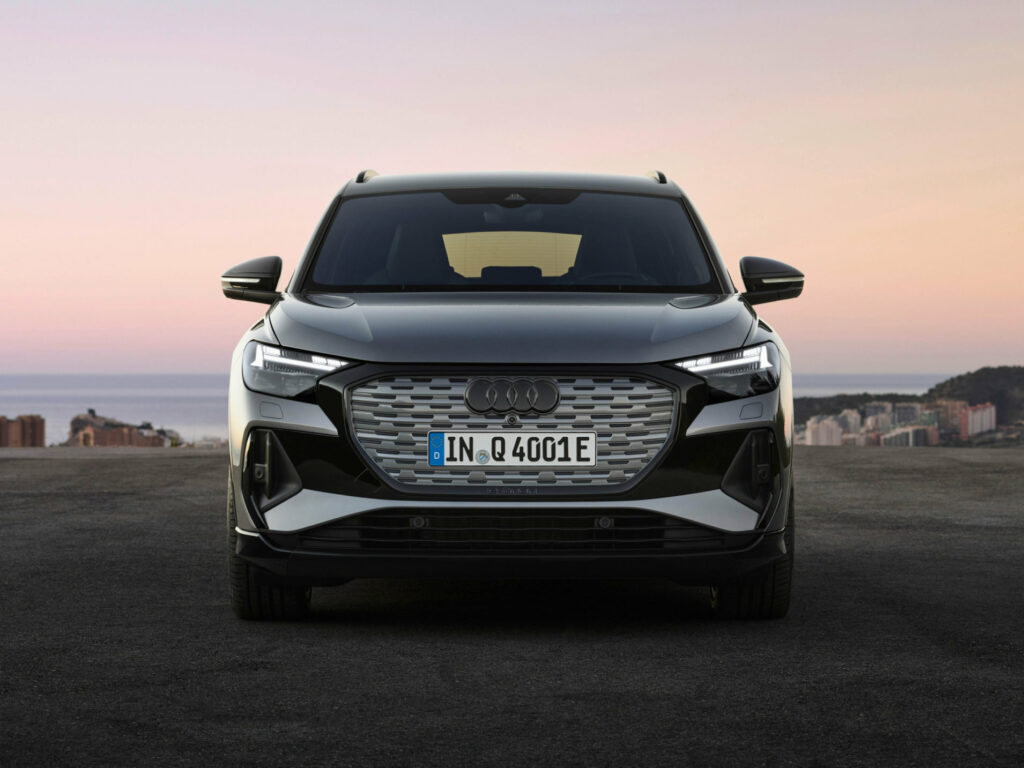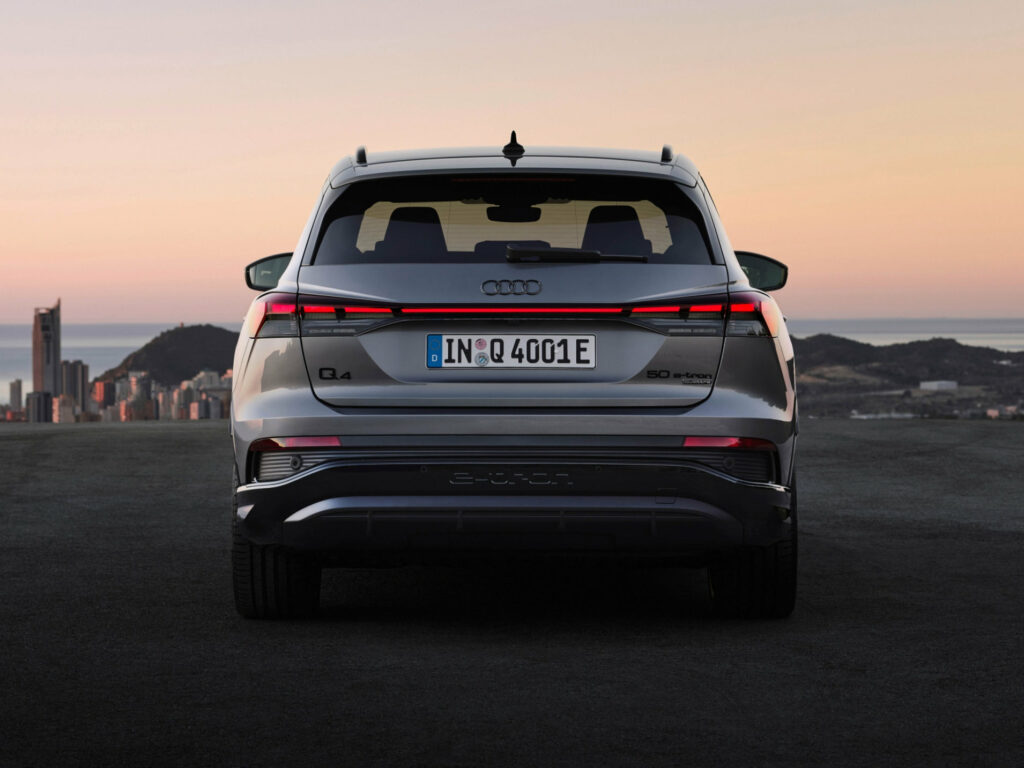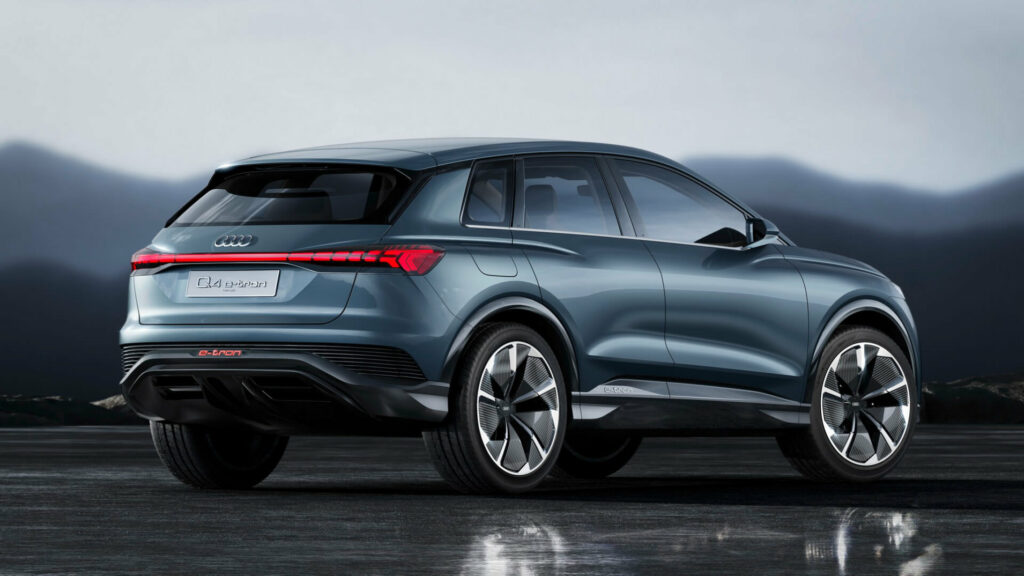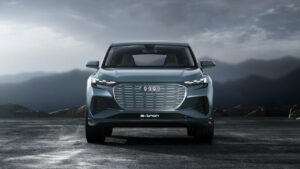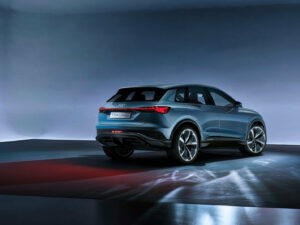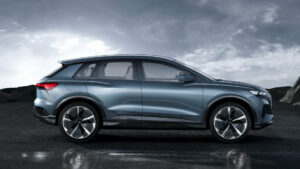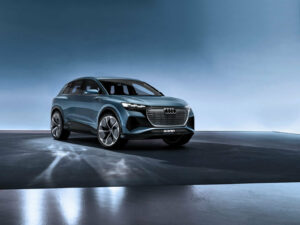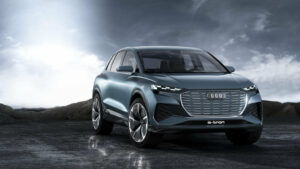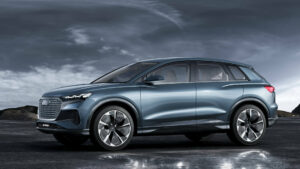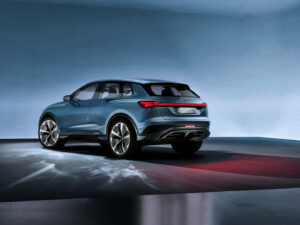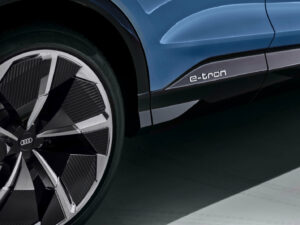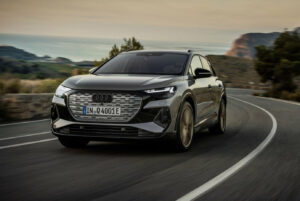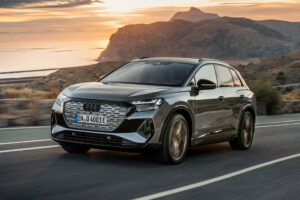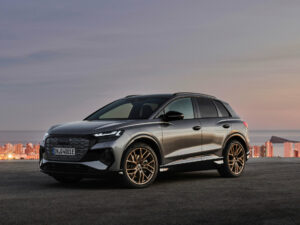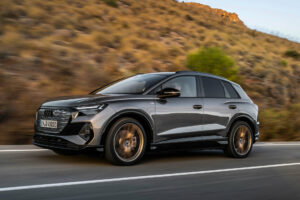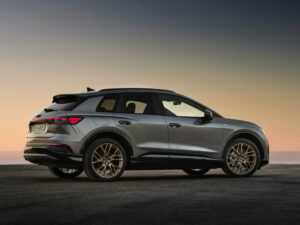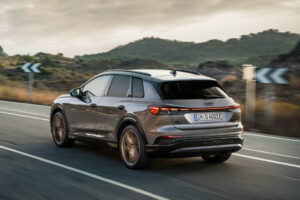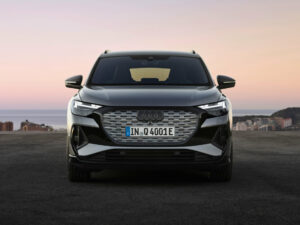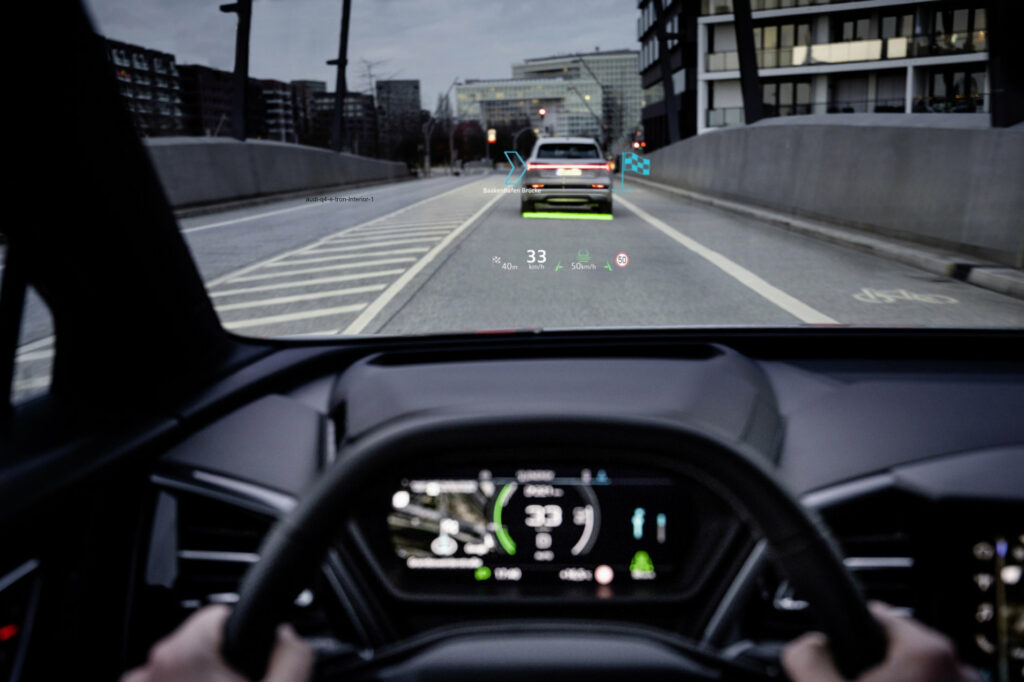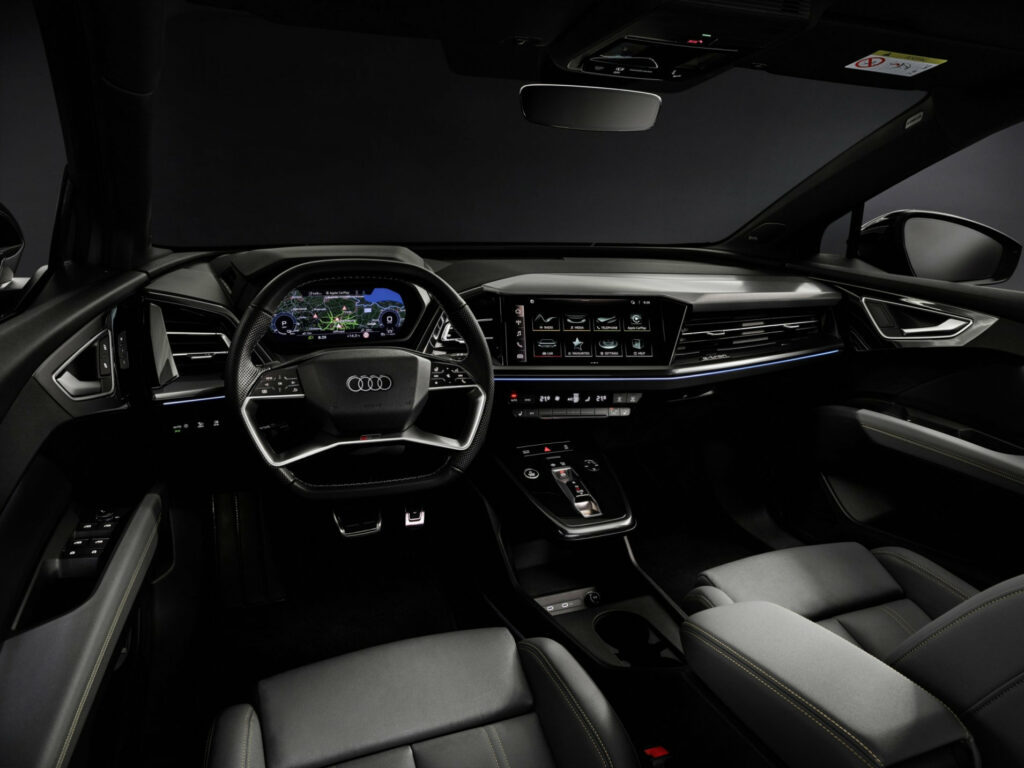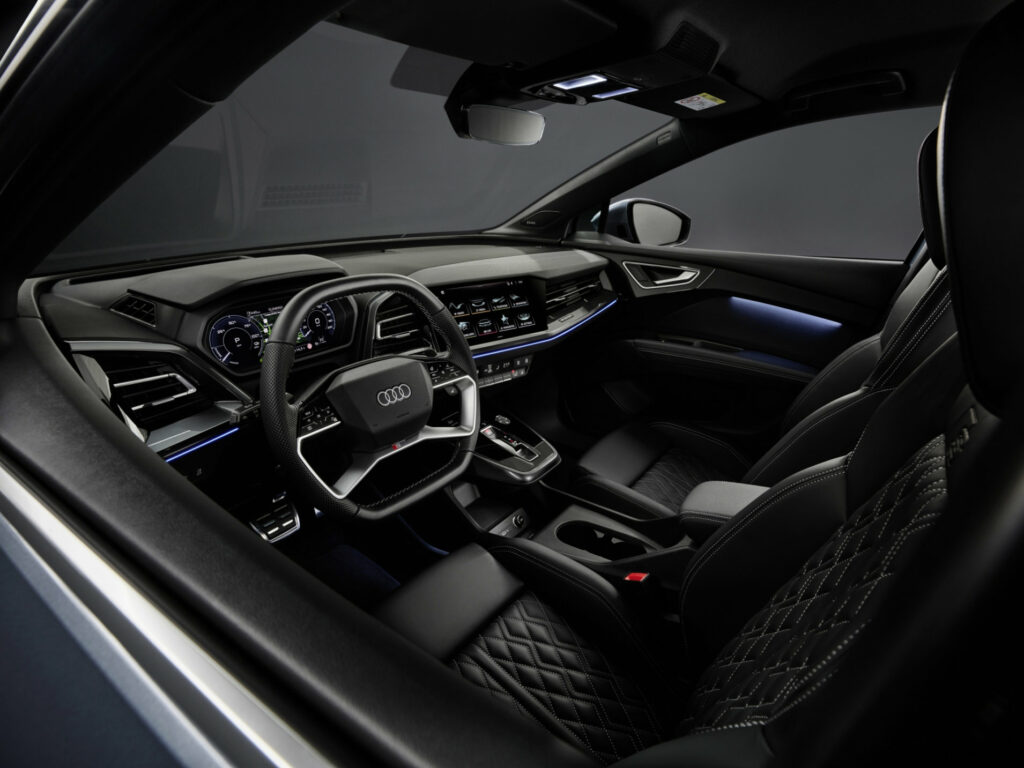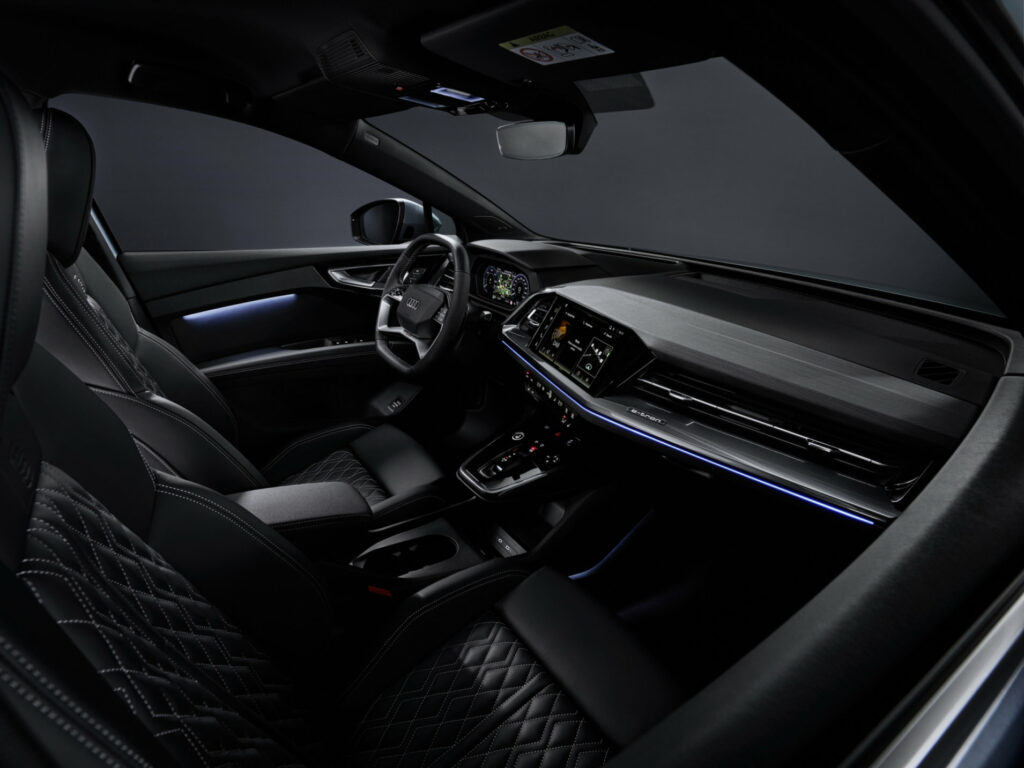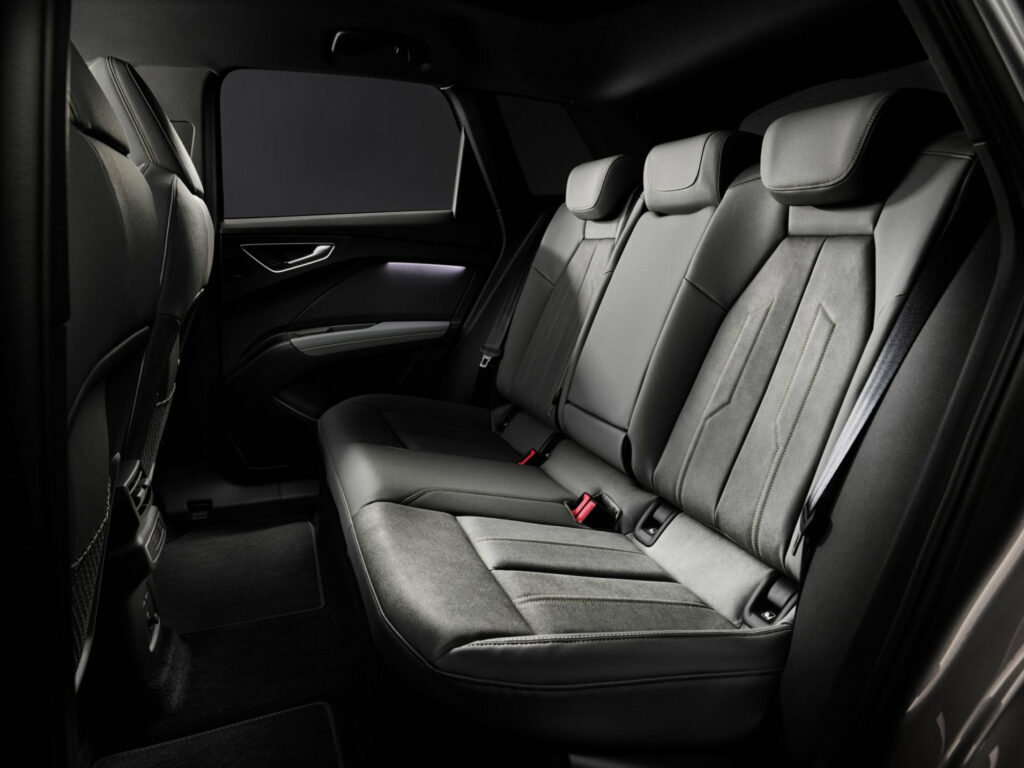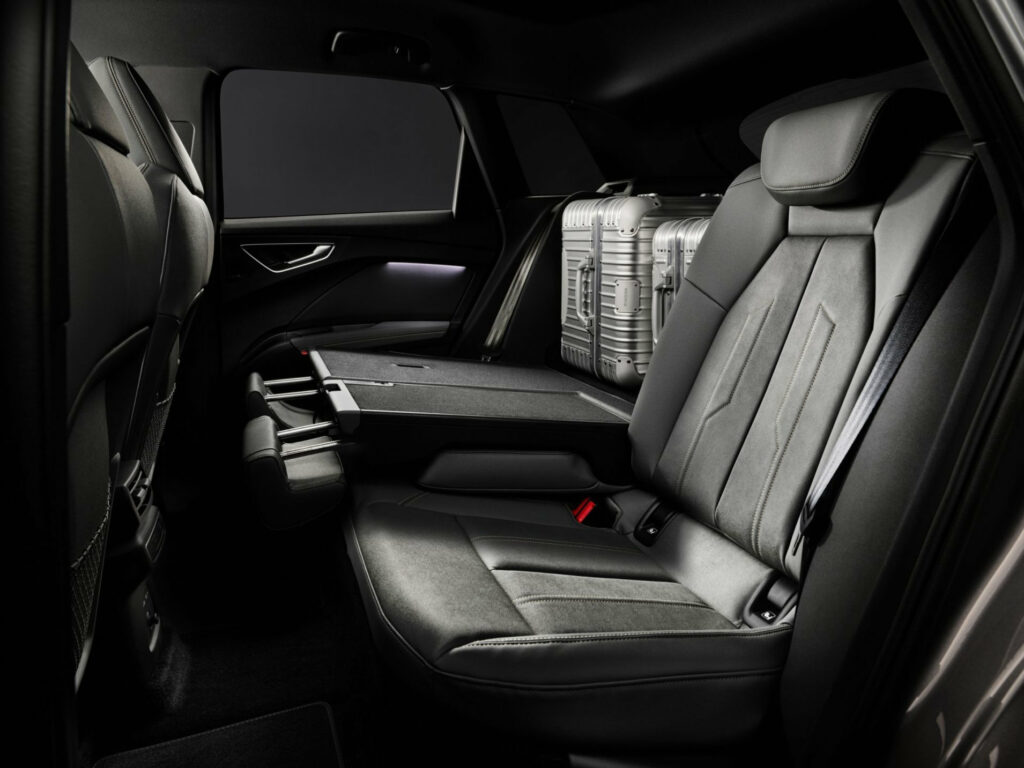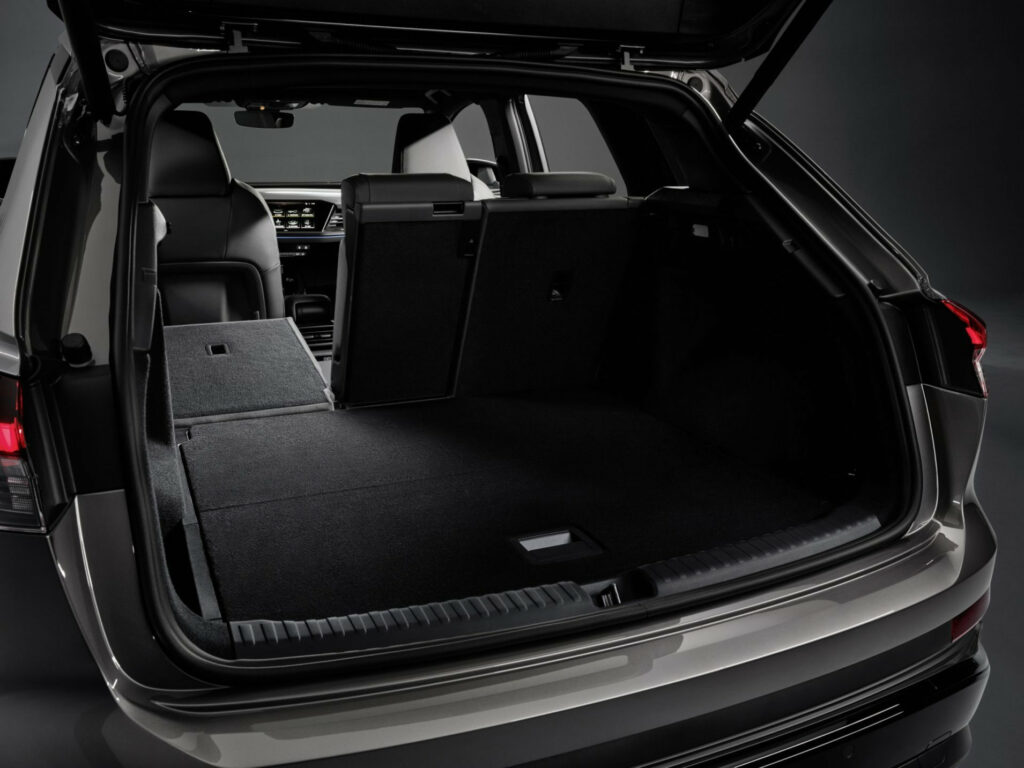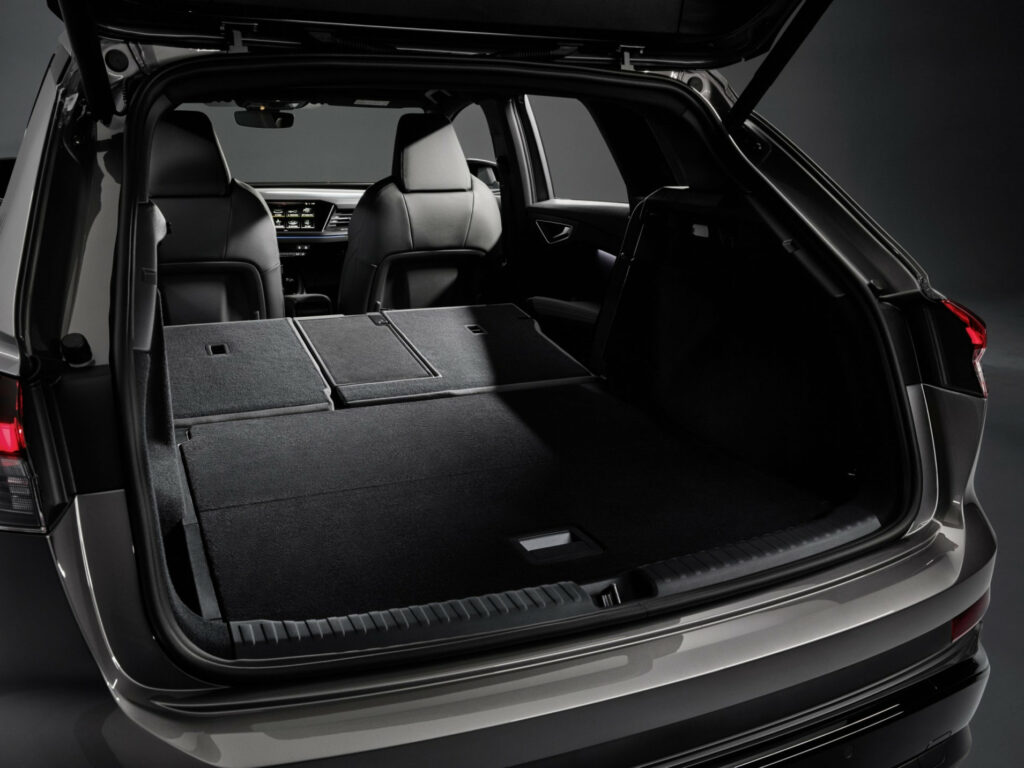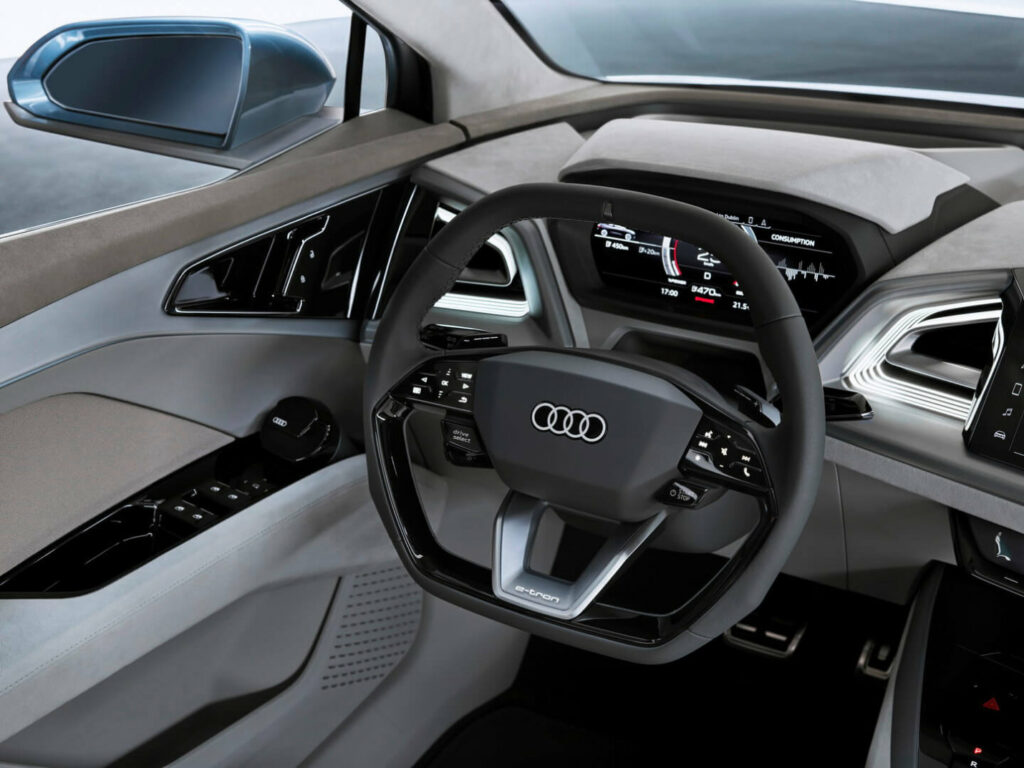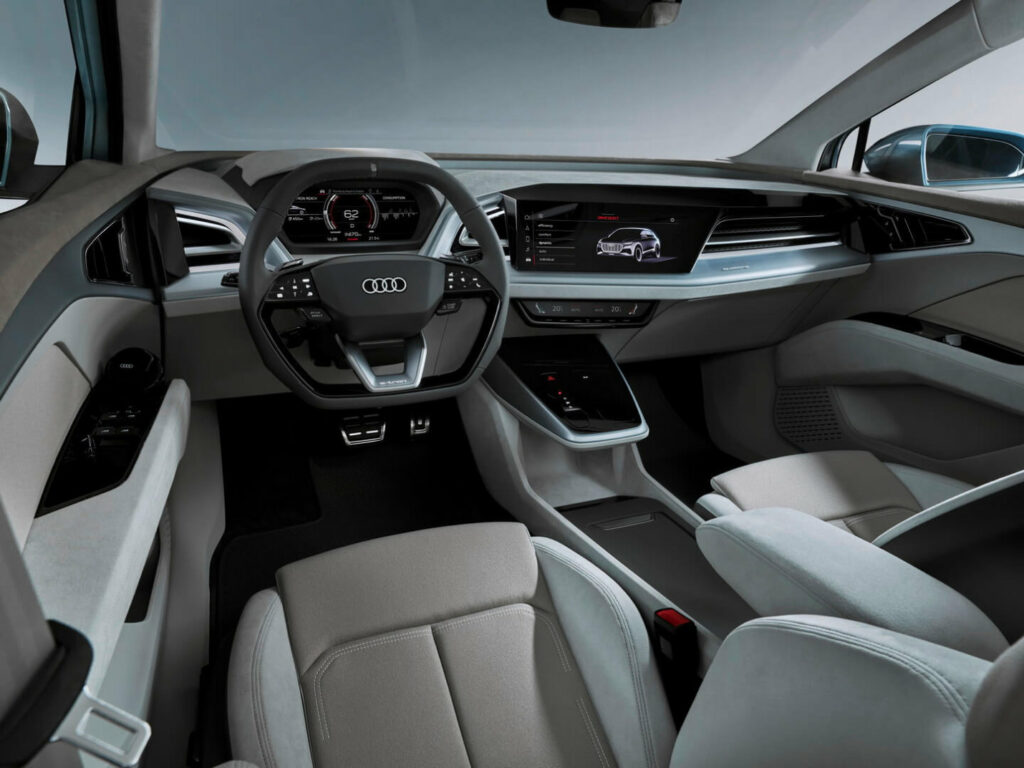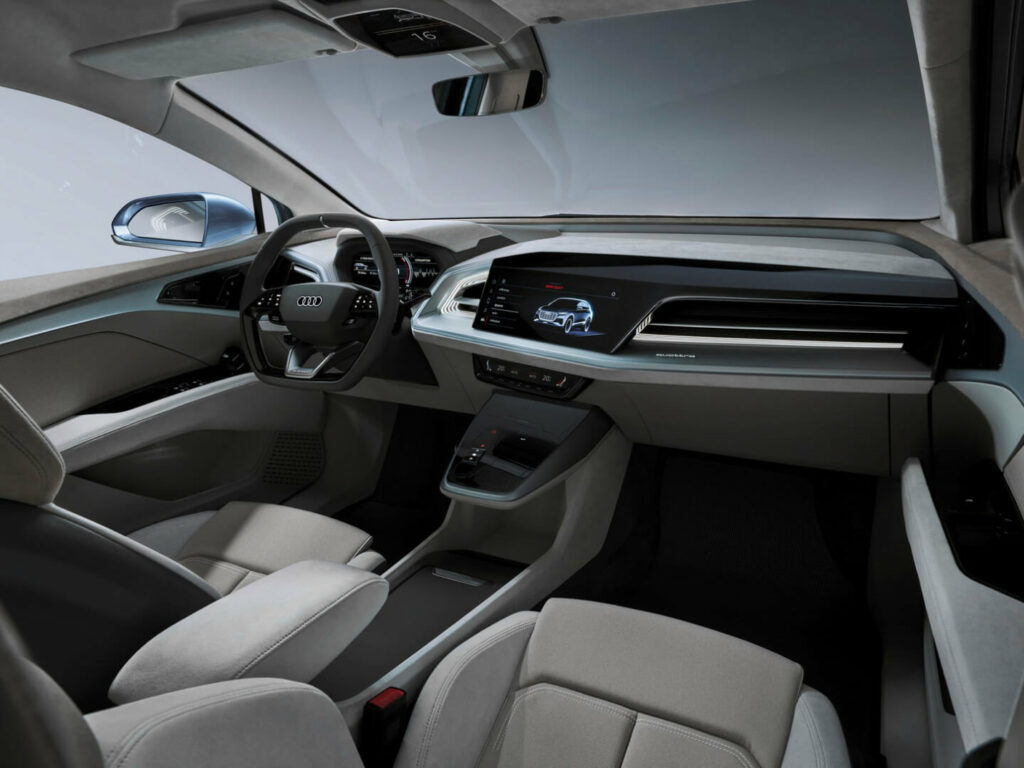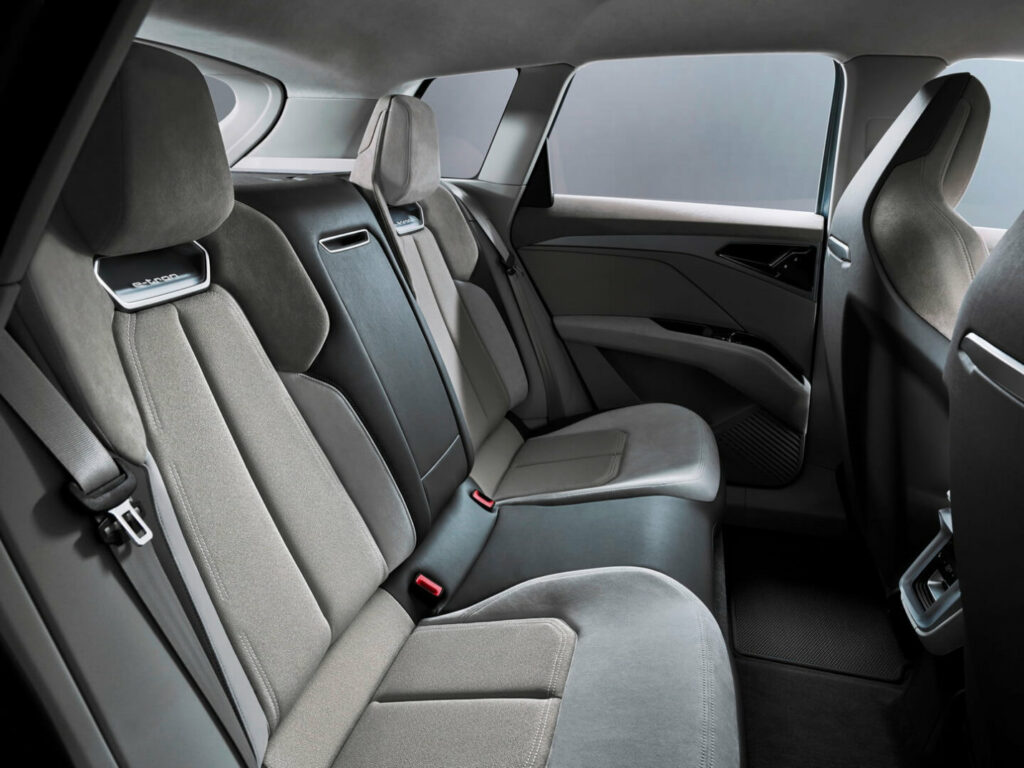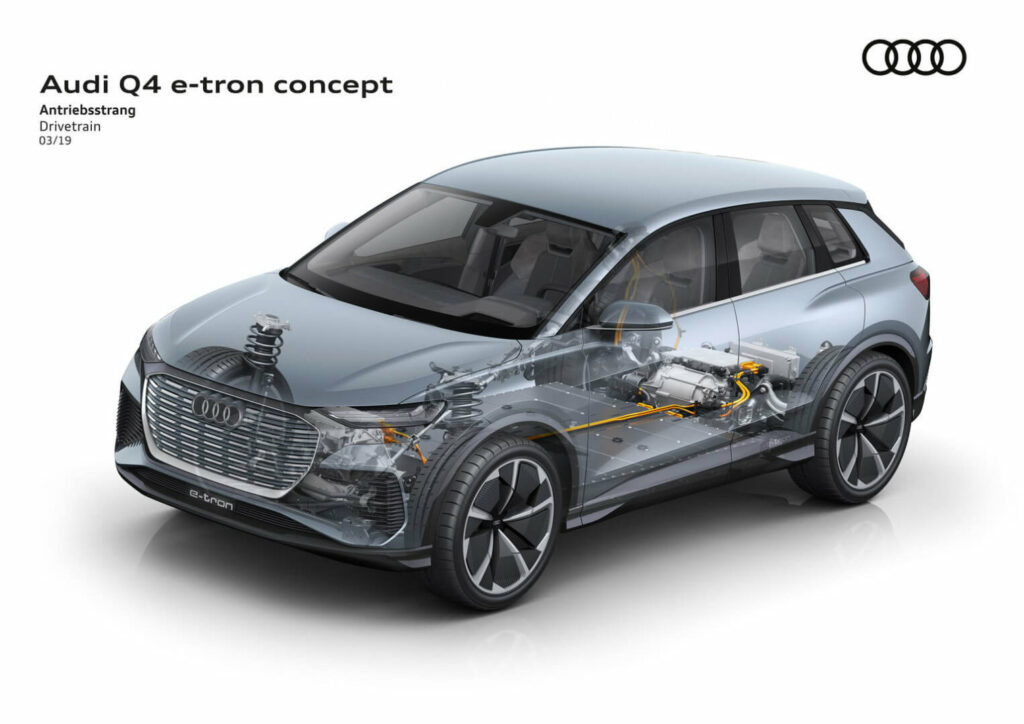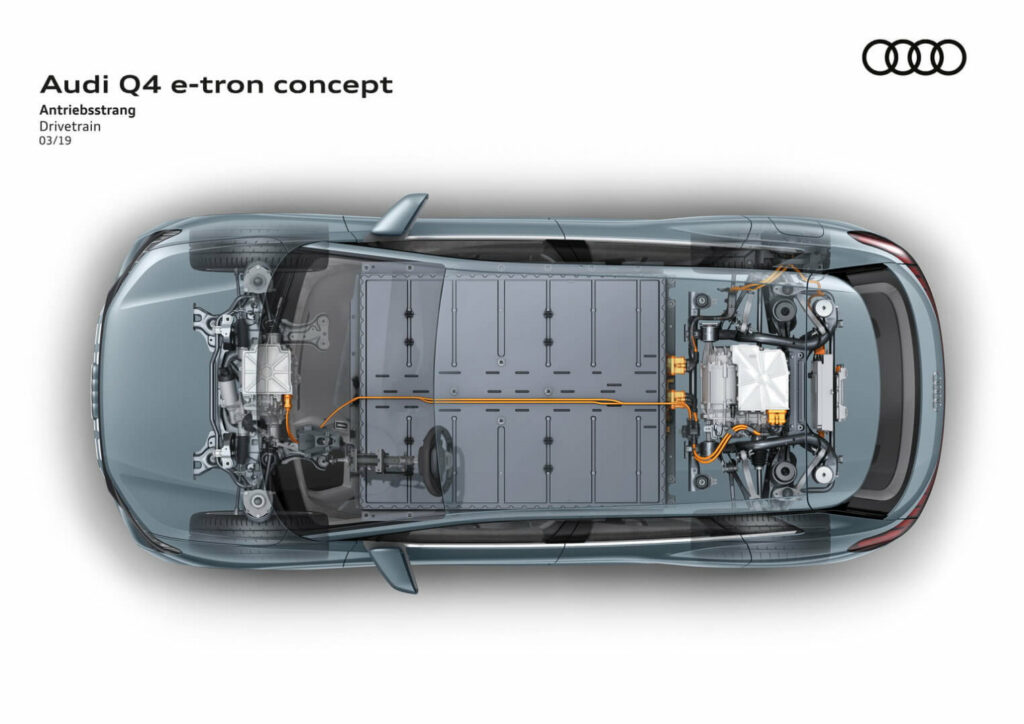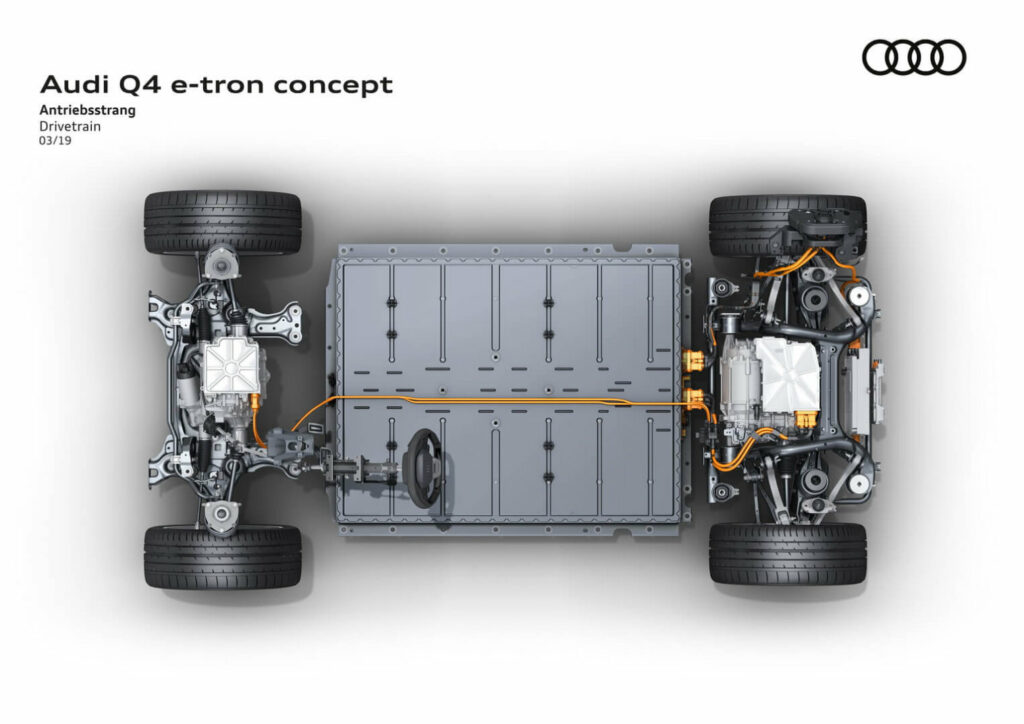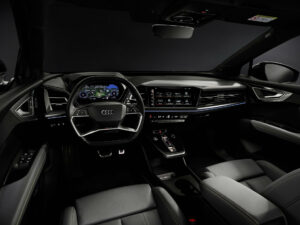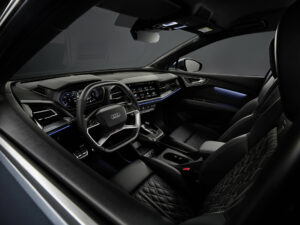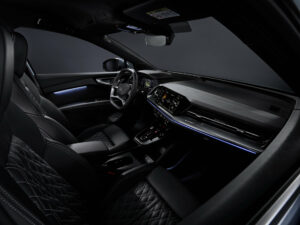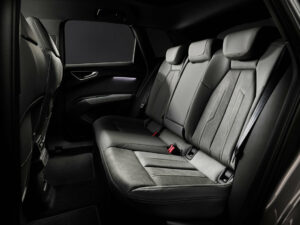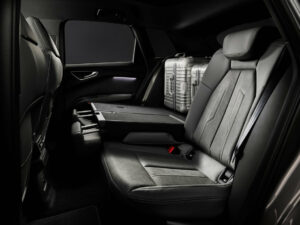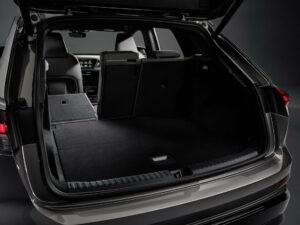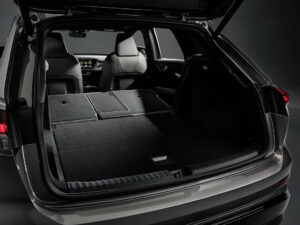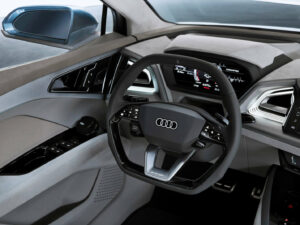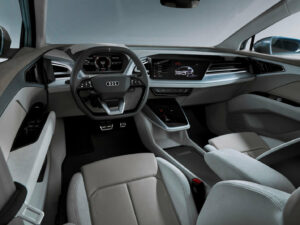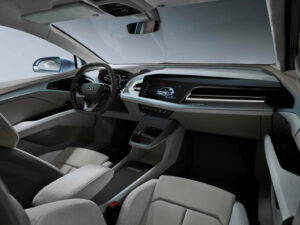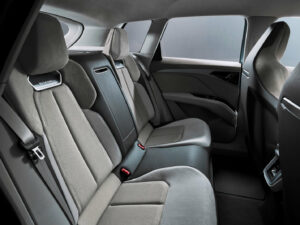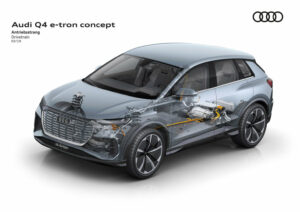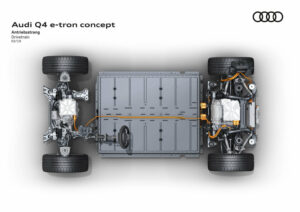Audi Q4 Sportback e-tron 50 quattro
Audi Q4 e-tron is a rear- or all-wheel drive electric crossover of the “K2” class. The first generation of the model. The car premiered on April 2021.
The Q4 electric crossover is built on the MEB platform, the Volkswagen Group’s modular “bogie” for electric cars. Despite the abundance of sharp lines on the bumpers and body panels, as well as sloped front struts and large wheels (19-21-inch), due to their proportions the car looks quite massive – make yourself aware of a considerable height (1632 mm with a length of 4588 mm) and relatively short hood. It is possible to assume that the engineers tried to squeeze out of the electric platform a maximum of useful space for passengers.
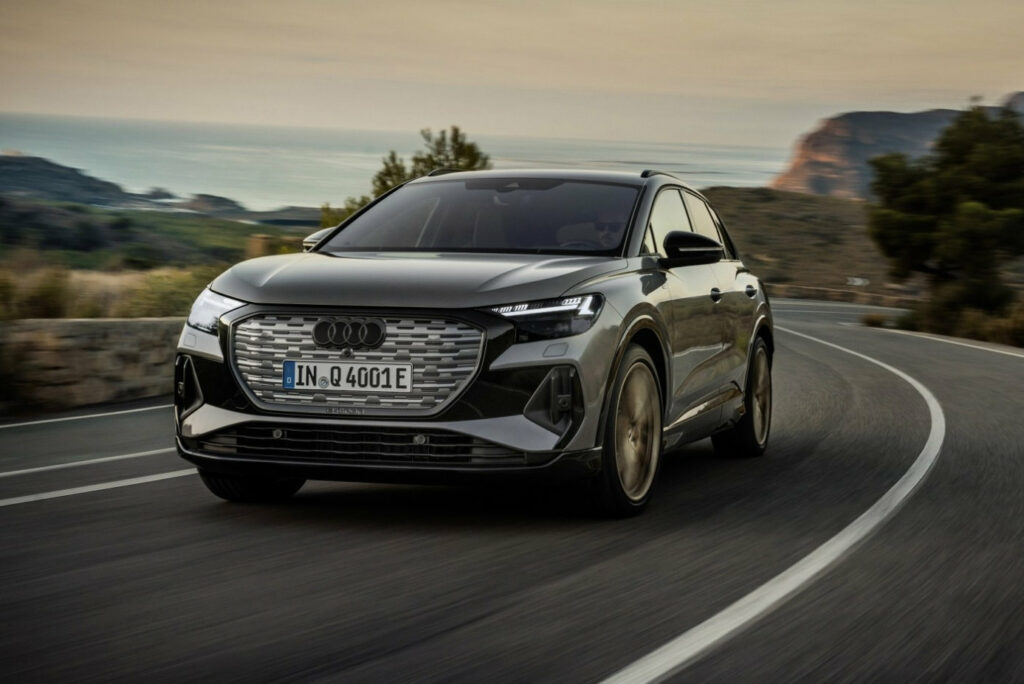
The latter will find inside a mix of fresh ideas borrowed from electric flagship e-tron GT solutions. The steering wheel with cut segments truncated central tunnel, and air deflectors stretched in all widths of the panel can be listed among the first ones. The second belongs to the central display turned to the driver and the “climate” block with a monochrome display. However, the maximum possible size of the display of the multimedia system MMI touch here – is 11.6 inches, while in other models of the brand – 10.1 inches (at the time of this writing).
You can order a separate “climate” zone for rear-row passengers. The luggage compartment has 520 liters – as much as in the larger Audi Q5. If to fold backs of a back row, the trunk increases up to 1490 liters.
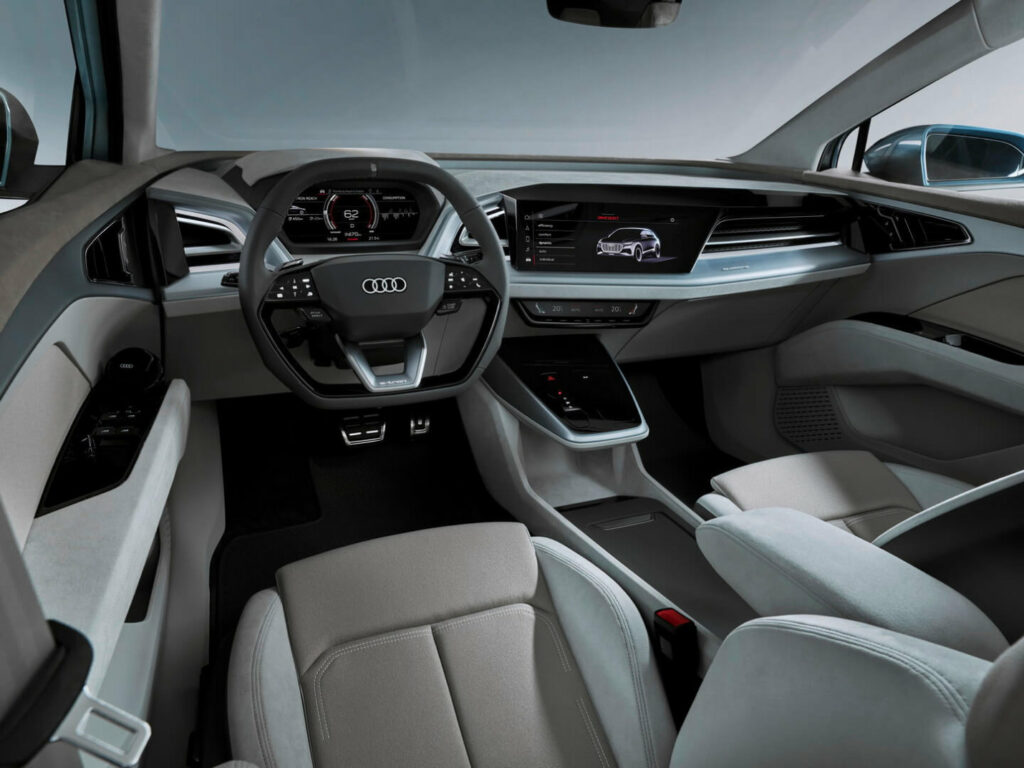
Q4 e-tron is available in one of three configurations. The base version 35 e-tron is equipped with an electric motor with 170 hp and 310 Nm, the output of which is provided by a 55-kilowatt battery (51.5 kWh is used). It accelerates to 100 km/h in 9 seconds and has a range of 341 km – on the WLTP cycle. The intermediate version, but the most “long-range” is the 40 e-tron: 204 hp and the same 310 Nm, 82 kWh (76.7 kWh is used), range – up to 520 km. The 40 e-tron covers the first “hundred” in 8.5 seconds. The most powerful version is the 50 e-tron quattro, with a synchronous electric motor at the front axle. The total output of two motors – 299 hp and 460 Nm, which accelerate up to 100 km/h in 6.2 seconds, range (using the same battery as in the 40 e-tron) – 488 km.
An electric car can be equipped with adaptive shock absorbers and variable-ratio steering, adaptive cruise control with a traffic jam assistant and lane-keeping system, as well as 360-degree-view cameras. It is also worth mentioning the projection display, which displays information (for example, from the navigation system) on the windshield, adjusting its view to the road in real-time
| Performance | |
| Acceleration 0 – 100 km/h | 6.2 sec |
| Top Speed | 180 km/h |
| Electric Range | 400 km |
| Total Power | 220 kW (299 PS) |
| Total Torque | 460 Nm |
| Drive | AWD |
| Battery and Charging | |
| Battery Capacity | 82.0 kWh |
| Battery Useable | 76.6 kWh |
| Europe | |
| Charge Port | Type 2 |
| Port Location | Right Side – Rear |
| Charge Power | 11 kW AC |
| Charge Time (0->400 km) | 8h15m |
| Charge Speed | 49 km/h |
| Fastcharge Port | CCS |
| FC Port Location | Right Side – Rear |
| Fastcharge Power (max) | 126 kW DC |
| Fastcharge Time (40->320 km) | 34 min |
| Fastcharge Speed | 490 km/h |
| Energy Consumption EVDB Real Range | |
| Range * | 400 km |
| Vehicle Consumption * | 192 Wh/km |
| CO2 Emissions | 0 g/km |
| Vehicle Fuel Equivalent * | 2.2 l/100km |
| WLTP Ratings (TEL) | |
| Range | 497 km |
| Rated Consumption | 175 Wh/km |
| Vehicle Consumption | 154 Wh/km |
| CO2 Emissions | 0 g/km |
| Rated Fuel Equivalent | 2.0 l/100km |
| Vehicle Fuel Equivalent | 1.7 l/100km |
| WLTP Ratings (TEH) | |
| Range | 420 km |
| Rated Consumption | 209 Wh/km |
| Vehicle Consumption | 182 Wh/km |
| CO2 Emissions | 0 g/km |
| Rated Fuel Equivalent | 2.3 l/100km |
| Vehicle Fuel Equivalent | 2.0 l/100km |
| TEL = Test Energy Low | TEH = Test Energy High | |
| Rated = official figures as published by manufacturer. Rated consumption and fuel equivalency figures include charging losses. | |
| Vehicle = calculated battery energy consumption used by the vehicle for propulsion and on-board systems. | |
| Real Energy Consumption Estimation between 132 – 264 Wh/km | |
| City – Cold Weather * | 194 Wh/km |
| Highway – Cold Weather * | 264 Wh/km |
| Combined – Cold Weather * | 225 Wh/km |
| City – Mild Weather * | 132 Wh/km |
| Highway – Mild Weather * | 207 Wh/km |
| Combined – Mild Weather * | 167 Wh/km |
|
Energy use for each trip will vary considerably depending on the driver and the conditions. Therefore, we have provided a range of estimates which can be useful in developing an understanding of the potential benefits of this technology. |
|
| Dimensions and Weight | |
| Length | 4588 mm |
| Width | 1865 mm |
| Width with mirrors | 2108 mm |
| Height | 1614 mm |
| Wheelbase | 2764 mm |
| Weight Unladen (EU) | 2215 kg |
| Gross Vehicle Weight (GVWR) | 2715 kg |
| Max. Payload | 575 kg |
| Cargo Volume | 535 L |
| Cargo Volume Max | 1460 L |
| Cargo Volume Frunk | 0 L |
| Roof Load | 75 kg |
| Tow Hitch Possible | Yes |
| Towing Weight Unbraked | 750 kg |
| Towing Weight Braked | 1200 kg |
| Vertical Load Max | 75 kg |
| Miscellaneous | |
| Seats | 5 people |
| Isofix | Yes, 3 seats |
| Turning Circle | No Data |
| Platform | VW MEB |
| Car Body | SUV |
| Segment | JC – Medium |
| Roof Rails | Yes |
| EV Dedicated Platform | Yes |
Home and Destination Charging (0 -> 100%)
A public charging station is required to use the highest possible charging rate. The EVSE/charging station’s charging capacity affects how long it takes to fully charge the battery. The table below shows all possible options for fully charging the Audi Q4 Sportback e-tron 50 quattro
In Europe, plugging an electric car into an outlet is often as easy as plugging it into a household outlet, but there are differences from country to country. The table below shows the different ways to charge the Audi Q4 Sportback e-tron 50 quattro , but in some countries some chargers may not be available.
Type 2 (Mennekes – IEC 62196)

| Charging Point | Max. Power | Power | Time | Rate |
| Wall Plug (2.3 kW) | 230V / 1x10A | 2.3 kW | 39h15m | 10 km/h |
| 1-phase 16A (3.7 kW) | 230V / 1x16A | 3.7 kW | 24h30m | 16 km/h |
| 1-phase 32A (7.4 kW) | 230V / 1x32A | 7.4 kW | 12h15m | 33 km/h |
| 3-phase 16A (11 kW) | 400V / 3x16A | 11 kW | 8h15m | 48 km/h |
| 3-phase 32A (22 kW) | 400V / 3x16A | 11 kW | 8h15m | 48 km/h |
Fast Charging (10 -> 80%)
If you want to enjoy driving an electric car, one of the most important features to consider is the number of miles per hour the car can travel while charged. This is called the “range” of the car. All electric cars have a certain range, even if they are 100% charged. This is because they do not have an internal combustion engine to lean on if you need to drive a long distance.
Max. Power: The maximum power provided by the charging point
Avg. Power: The average power provided by the charging point during a session of 10% to 80%.
Time: the time it takes to charge from 10% to 80%
Speed: the average charging rate during the session of 10% to 80%
Combined Charging System (CCS Combo 2)
| Charging Point | Max. Power | Avg. Power | Time | Rate |
| CCS (50 kW DC) | 49 kW | 49 kW | 69 min | 240 km/h |
| CCS (175 kW DC) | 126 kW | 101 kW | 34 min | 490 km/h |
| CCS (350 kW DC) | 126 kW | 101 kW | 34 min | 490 km/h |
| Brand | Audi |
| Model | Q4 e-tron |
| Body Style | SUV |
| Car Engine | electric |
| Motor power | 220 |
| Maximum Torque, Nm | 460 |
| Battery Energy, kWh | 82 |
| Power reserve (NEDC/EPA/WLTP), km | - / - / 400 |
| Level Charging (230/400/DC), hours | - / 8,15 / 0,34 |
| Electrical Acceleration, 0-100 km/h (0-62.1 mph) in sec | 6.2 sec |
| Top Speed, km/h | 180 |
